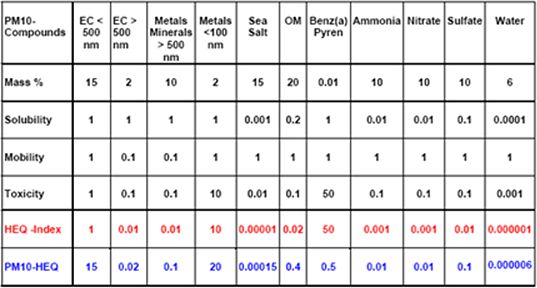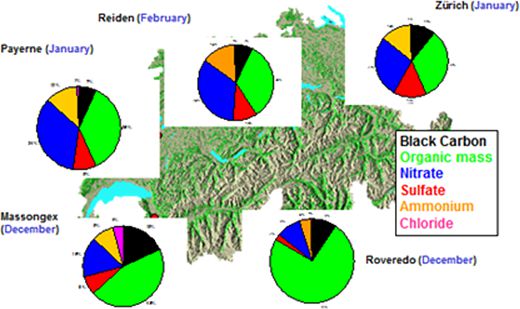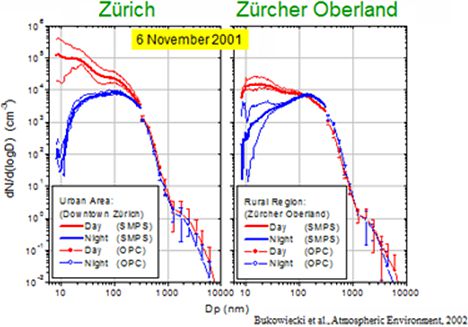Andreas Mayer: Open letter on NO2 health effects
Open Letter
22 September 2017
This is an open letter, addressed to the authors of the paper:
Impact of excess NOx emissions from diesel cars on air quality, public health and eutrophication in Europe
J.E. Jonson et al.
IOP Publishing, Environ. Res. Lett. 12 (2017) 094017
and the responsible staff of the journal.
I am writing because I am upset about the missing professionality of your study, the low scientific level, the falsified facts and the absolutely insufficient justifications of your conclusions and I feel this paper must be recalled and the authors must publish an apology in the journal.
I am proud to be a mechanical engineer based on solid science and received my first award on scientific engineering, the famous Ferdinand Redtenbacher Medal from the University of Karlsruhe, today KTI over 50 year ago. I became an R&D engine engineer in supercharging and from the early 1970s also in emission reduction. With BBC and ETH we developed emission reduction technologies for Diesel-LDV and HDV which made those engines already in 1985 nearly as clean as they can be today and we worked with SCR for large engines reducing NOx by > 98% since 1992. In the very early nineties, then independent, I became responsible for the introduction of particle filters (DPF) in Swiss Tunneling with the unique requirement that efficiency for alveoli-penetration solid particles < 500 nm must be > 97% by particle number (PN) and no secondary emissions are permitted. With an outstanding team of experts, we called it the VERT network, this was finally extended to all other Diesel vehicles in Switzerland and became the basis for the introduction of DPF, the SDPF and GPF in Europe following the BAT philosophy. Even retrofitted DPF-engines are now super-clean and we, the emission engineers, who teamed up with scientists from chemistry, physics, biology and medicine to start the ETH Nanoparticle conference in 1997—the incubator for this new technology—we are proud on what we have achieved with this worldwide expert network to clean the breathing air and rescue millions of lives. We also do this for Chinese, Iranian and Latin American megacities. You can find our names on many technical and research papers. The professional society honored me for my engineering work with the Fellowship of the SAE, the Society of Automotive Engineers, where my peer was John J. Mooney, an inventor of the three way catalyst which cleans petrol engines, and for my contribution to public health I received a Dr. med. h.c. from the University of Berne.
With this background you may understand that nobody was more upset than me to hear about the criminal things VW and others did with emission control electronics which produce low emissions during legal test cycles but emit 10-30 times more NOx on the road. I was an expert-member of the VW scandal hearing of the German Bundestag in Berlin in September 2016 and used very clear language in my testimony. I would like to see these responsible managers all in prison for murder and their money given to children’s hospitals.
But listen: from the point of science ethics what you did is on a similar level of fake. I will explain you why.
You don’t seem to know much about the complex phenomena of engine combustion, the formation of emission compounds, their modification in atmosphere nor the health effect science, the “bone-breaking” work of occupational medicine, toxicology and epidemiology to come up with limit concentrations for air toxics.
You neither know that the petrol engine, which you regard to be cleaner than Diesel, emits more NOx than the Diesel, which is needed for the three-way catalyst process and the endpipe is only clean from NOx, HC and CO if this process is working perfect, which is not necessarily the case and can fail for many reasons.
You neither seem to know that many of these petrol engines emit nearly as many ultrafine particles as the old Diesels did (some even more)—even smaller and therefore more dangerous, nor that the metal oxide content, which might be the most toxic part in these vehicle emissions, tends to be higher than with Diesels, since petrol engines use higher RPM.
But, listen: now all 120 million of LD and HD Diesels in Europe have filters with > 99% efficiency and Petrol Engines have not. Today’s petrol engines must therefore be regarded the high polluter and not the Diesel. And this is the big problem of many polluted megacities.
You did not know that?
And more in detail:
- You mention that you have no solid base for premature mortality of NO2 in form of confirmed dose/effect factors. As an honest scientist at this point you should have stopped writing a patchwork of assumptions since if you have no information on toxicity, even less on mortality of a substance, how can you expect to evaluate solid results on premature mortality due to this substance?
- But even this statement is not fully correct, because if you would dig a bit more diligently into the literature including occupational health you would indeed find information. You know what I believe: you did and you realized that the concentration levels of NO2 where health effects are observed are outside of what would be useful for your purpose and so you decided to suppress this information. And this, Sir, is unforgivable.
- And than you “elegantly circumvented” the problem—as Prof. Künzli expressed it when citing you work during 21st ETH-NPC—by stating that NO2 is forming particles (precursor of particles, http://www.orf.at/stories/2407385/) in the atmosphere, which is basically true. There are different processes, ending up with nitrate and ammonia particles, which have been thoroughly investigated. Even NO2 from Diesels can form nitrates during SOA process but this does not happen anymore with modern Diesels having BAT catalyzed DPF—didn’t you know?
- Formation of nitrates does not happen in street canyons, it needs time—you mentioned this somewhere in a remark but then you cannot use it for your argumentation.
- So you simply estimated a certain amount of nitrate particles. But did you find dose-effect factors for nitrate particles? No, you did not because this does not exist, even less than for NO2, unless at the working place MAK at high levels.
- But by far the most severe and upsetting fake is that you simply assumed that the toxicity of these “by NO2 somehow generated” particles is equal to the well established dose/effect factors for solid combustion generated particles. This cannot be an error, it is intentional fake! Have you never given a thought to the chemical/morphological difference of these and other substances contained in PM? Nitrate particles are larger than combustion aerosols, are hydrophilic and soluble in the lung surface liquids. They disappear before they even reach the alveoli, see HEQ systematics below, following M. Kasper on www.nanoparticles.ethz.ch.
- All this does not mean, that adverse health effects by NO and NO2 from vehicle exhaust gas can be neglected. Absolutely not. There might be strong effects at some concentration and in some combination with other toxics but Sir, we must honestly admit that we do not know—and replacing knowledge by wishful estimations is the opposite of science, unforgivable third time. What must be done in such cases is to establish precautionary limits and this has been done by the governments based on serious observations and these limits are legal boundaries and must be respected. Science however must continue research to come up with well proven dose/effect information on whatever endpoints and avoid any wishful thinking.
And after all you come up with conclusions of thousands of death to draw the attention of the press to a paper which in its essence is nothing but fake.
So once again, this paper is a shame for you and your co-authors and the journal which printed it. And I strongly recommend to recall it and publish an apology in the journal.
Yours Sincerely,
Andreas C.R. Mayer
Dipl. Ing., SAE Fellow
Dr. med. h.c.,
0041 56 4966414
ttm.a.mayer@bluewin.ch
PS: We invite you to the next ETH-NPC to see how much brainwork is needed to develop these air cleaning technologies and which large and highly committed community is devoted to this.
* * *
PM10 HEQ Approach to a Health-Oriented PM Characterization, M. Kaspar et al.



Response by Paper Authors
6 October 2017
Dear Mr Mayer,
Cc: IOP publishers, experts initially addressed by Mr Mayer
Thank you for your open letter dated 23 Sept 2017. Unfortunately most of the harsh allegations do not relate to our paper on the “Impact of excess NOx emissions from diesel cars on air quality, public health and eutrophication in Europe”[1]. We stand by our analysis and object to its misinterpretation.
You argue about primary PM emissions from gasoline and diesel cars, but they are outside our impact assessment. All remarks concerning particle emissions of diesel or petrol cars, with or without particle filters, are hence of no direct relevance to our analysis.
We focus on assessing the health impact of NOx emissions from diesel cars and light commercial vehicles. Unquestioned, emissions are far higher in real driving than under certification test conditions, contributing to atmospheric NO2, ozone and fine particulate matter (PM). The chemical formation mechanisms are tackled with a thoroughly reviewed chemical transport model.
For the health impact assessment, we follow the consensus recommendations of the World Health Organization (WHO)[2]. They are based on an extensive review of the evidence on the health aspects of air pollution[3]. While there is some evidence linking particular sub-components of PM2.5 with specific health impacts, for instance those related to primary combustion, the balance of evidence, and WHO, favour retaining PM2.5 mass as impact metric. Of course there are uncertainties but it has not been our intention to develop a new method nor new risk factors. We apply the recommended risk factors; any dissent should be addressed to the WHO.
We focus on the impact from secondary particulate matter only; this is not a trick, as insinuated, but avoids potential double-counting with direct impacts from NO2. Thus we are conservative and do not inflate the estimated number of premature deaths[4].
There is no question that today’s catalyst-equipped petrol cars have much lower NOx emissions on the road than diesel cars. There is no evidence of widespread disabling or significant deterioration of the catalytic converter in Europe[5]. Any suggestion in this direction simply lacks foundation. Therefore, it is no surprise that it would lead to fewer premature deaths if diesel cars would emit as little NOx as petrol cars. At no place in our article do we call petrol cars clean, as protested.
We adhere to strict scientific standards and underwent peer review. All assumptions are clearly documented and support our conclusions. That is actually the ground for publication in a high quality journal. We kindly ask you to refrain from further publication of unjustified allegations, or submit a formal letter to ERL so that we may conduct this discussion with scientific standards.
Laxenburg/AT, Oslo/NO, 5 Oct 2017
J. Borken-Kleefeld, J.E. Jonson, D. Simpson, A. Nyíri, M. Posch and C. Heyes
For correspondence:
Dr. Jens Borken-Kleefeld
Air Quality and Greenhouse Gases Program
IIASA - International Institute for Applied Systems Analysis
Tel.: +43-2236-807 570
Footnotes:
- J E Jonson et al., ‘Impact of Excess NOx Emissions from Diesel Cars on Air Quality, Public Health and Eutrophication in Europe’, Environmental Research Letters 12, no. 9 (18 September 2017): 094017, doi:10.1088/1748-9326/aa8850.
- WHO Regional Office for Europe, ‘Health Risks of Air Pollution in Europe – HRAPIE Project’ Bonn, Germany: World Health Organization 2013.
- WHO Regional Office for Europe, ‘Review of evidence on health aspects of air pollution – REVIHAAP project: technical report’ Bonn, Germany: World Health Organization, 2013.
- Premature deaths from additional NO2 due to excess NOx emissions could be substantial indeed: Chossiere et al., ERL 12 (2017) 034014 attribute about 1300 additional premature deaths to excess emissions in Germany from Volkswagen group’s diesel cars compared to 1200 premature deaths due to induced PM2.5 changes over the period 2008 to 2015.
- Y. Chen and J. Borken-Kleefeld, ‘Real-Driving Emissions from Cars and Light Commercial Vehicles – Results from 13 Years Remote Sensing at Zurich/CH’, Atmospheric Environment 88 (May 2014): 157–64, doi:10.1016/j.atmosenv.2014.01.040;
D. C. Carslaw and G. Rhys-Tyler, ‘New Insights from Comprehensive On-Road Measurements of NOx, NO2 and NH3 from Vehicle Emission Remote Sensing in London, UK’, Atmospheric Environment 81 (December 2013): 339–47, doi:10.1016/j.atmosenv.2013.09.026;
EEA, ‘EMEP/EEA Air Pollutant Emission Inventory Guidebook’, Technical report (Copenhagen, Denmark: European Environmental Agency (EEA), 2013).
Response by Andreas Mayer
7 October 2017
Dear Dr. Borken,
I appreciate your response, but I am very sorry to repeat myself saying that you obviously have not understood the main point!
So I will try again:
Particles of different size, different chemical substance and different morphology have different toxicity so different health effects. PM2.5 is a conglomerate of different particles < 2.5 µm aerodynamic diameter and there is an agreement of overall CRF. But as always with conglomerates this is heterogeneous (with respect to size and substance) and you cannot take “pars pro toto”. Some of the constituents may have high toxicity and others definitely have no toxicity.
There is evidence that all water soluble constituents have no or very low toxicity (Oberdörster, Kreyling, Heyder, Gehr, SUVA, TBG) and that insoluble (persistent) constituents can have very high toxicity (Wichmann, Peters, Gehr et many others).
Highest health effects are expected from persistent and ultrafine (translocating) particles, in particular if their large surface is activated by heavy metal clusters and PAH (Heeb)—this would fulfill the definition of combustion generated nanoparticles.
We have tried to break this down by two methods
- HEQ, which I have described and referenced last time. This comes to the conclusion that your assumed engine out NOx-derived secondary particles have a very low contribution to the PM2.5 health effect
- Metastudy following Katsuyanni (ETH-NPC 2012) analyzing 6 epidemiologic studies (Atkinson, Stolzel, Breitner, Branis, Forastiere, Kettunen), who correlated CVD in parallel to PM2.5 and to solid PN concentration in the same campaigns. If converting PN to mass, as we did, this indicates that the health effects can be explained by the effect of the solid PN only (see Mayer ETH-NPC 2014) and not the other constituents and so it supports HEQ
These are only approaches but they respect and integrate all the information we have on the effects of the PM2.5 constituents. It is an important challenge for the science and I am looking forward to serious research to better define and classify the toxicity of aerosols in order to provide a better decision basis for policies and technical countermeasures.
Your paper however is completely neglecting these important properties of different aerosols that contribute to PM2.5. Your paper is taking “pars pro toto”, which is not permitted. The secondary particles formed by engine-out NOx, which you assume, have most probably very low toxicity since they are hydrophilic, water soluble and large and you cannot use the same CRF which results from epidemiologic observations of PM2.5 in traffic dominated air.
And for this reason your methodology is false and your conclusions are wrong and misleading and your paper should be recalled.
On top of this I must confess that I am disappointed that you don’t even mention that all these new VW-vehicles have highly efficient DPFs (>99%) and the health effect due to these solid ultrafine combustion particles, which are much higher than what you calculated for NOx, must be deducted from the overall result. This would be fair in a scientific sense to avoid the touch of being biased.
Still, I would like to again emphasize that NO2 limit values in ambient air, which are based on a large treasure of medical observations and a very sound rational of limit value definition must be respected.
So my credo, if you like, is: emission of solid particles from combustion engines must be eliminated, NO2/NOx at engine exhaust should be as low as possible and NOx-limits must be respected under all driving conditions.
Regards,
Andreas C.R. Mayer
Dipl. Ing., Dr. med. h.c.
TTM Technik Thermische Maschinen
Fohrhölzlistrasse 14 b
CH 5443 Niederrohrdorf/Schweiz
+41 56 496 6414
ttm.a.mayer@bluewin.ch
Comment by Axel Friedrich
7 October 2017
Dear Mr. Mayer,
I think you raised the right questions but I don’t think the authors are aware of the issues. As long the EU, EPA and WHO are using this approach it is difficult for scientist which aren’t deep in the health research to use a different approach. I tried to convince e.g. the HEI to do an analysis of the epidemiological data. But they refused.
I think we should bundle our forces to convince the state bodies to adopt a e.g. number standard or BC standard.
I propose to organize a conference on the question what is a particle and what impact which particle has.
Best Regards,
Axel Friedrich
Source: Andreas Mayer | Jens Borken | Axel Friedrich